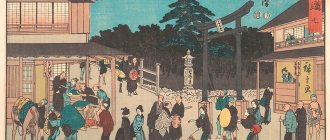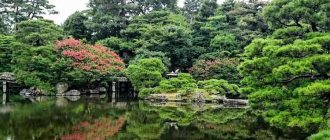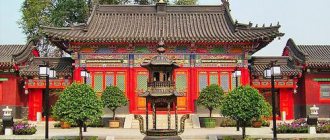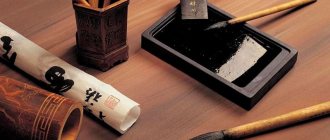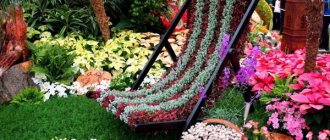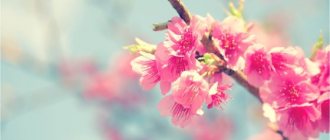What does history say?
The symbolic meaning of the stone has ancient roots. The religious schools of philosophy Zen Buddhism and Confucianism endow this part of inanimate nature with energy that carries calm, harmony and serenity. In Japan, the stone became an object of worship. This is where the idea of stone gardens originated.
At first, small compositions were made at monasteries and temples for contemplation and meditation. Today it is an element of the East in landscape design. But the Japanese still believe that such a miniature near the house will help achieve harmony with the world, avoid everyday problems and fuss.
Philosophy
Every detail of the composition is based on the teachings of Zen. It says that the world is as man sees it. By concentrating on a frozen picture, you can be alone with nature and hear your inner voice.
Photo: landscape design in Japanese style
Zen masters claimed that if you look long at a stone lying on the sand with waves drawn around it, you can see how it slowly sinks into the water.
The classic version of a garden composition made of stones is created according to the principles of Feng Shui. It is based on 4 elements: air, earth, water and fire. The role of the last element can be played by decorative lanterns. If it is not possible to equip an artificial reservoir, sand with curved lines and circles in the form of waves will be an alternative.
The traditional picture is completed by ceramic figures, fences, and low-growing plants. Nearby there is a Japanese-style gazebo or pergola.
When creating a Japanese garden, it is important not to disturb the symmetry of the arrangement of parts and to avoid cluttering the space.
Basic elements, symbolism and principles of the device
The size, number, shape and arrangement of all elements of the sekitai are important. Symbolism shines through in every detail.
Modern stone gardens are often adjacent to meditation areas.
Number of stones
Historically, sekitai uses 15 stones, which are grouped in groups of three in each mini-composition.
According to legend, the boulder has a soul, which means it must be treated with great respect. Selecting the best rock specimens can take years. Processing rocky fragments is not advisable; it is ideal if nature itself takes care of the shape and size of the stone elements.
In addition to simply arranging cobblestones in groups, there is a tradition of laying out sacred symbols from stones: cranes (the height of the human spirit), turtles (longevity), a mountain (the center of the universe) or the figure of Buddha
Modern gardens do not adhere to the rule of 15 units, but there is a strict condition that only an odd number of stones be used and, according to Japanese traditions, whatever the total number of boulders, they must be arranged so that it is impossible to see everything at the same time. Whatever angle the visitor chooses, he should see one less stone. If this canon is observed, we can assume that the sekitai has completed its task.
Location and arrangement of stones
There are several principles for arranging rocks:
- there should be more stones located horizontally than those standing vertically - this is necessary to balance the Yin-Yang energy, balancing the influence of vertical objects - trees, fences, buildings;
- providing emptiness against the backdrop of boulders - space is identified with freedom of spirit;
- lack of symmetry, parallel lines and elements of the same size;
- balanced composition in each group - for this purpose, a construction technique is used based on a triangle, where there is always a main element and several subordinates;
- a stone cannot simply lie on the surface, it must “grow” from the ground - it must be deepened so that it connects with the ground, grows into it, and on a slope stones are dug in more forcefully than on a flat surface;
- a beautiful view from seven viewing points - you need to mentally draw a heptagonal star, each of the ends of which can become such a point, and install stones on the seven faces of the figure, while the cobblestones, often except one, should be visible from all areas allocated for viewing.
A large stone rises like a rock, and a small one resembles a hill or an island, a vertical stone will represent the sky, and a flat stone will represent the earth
Sometimes visitors feel as if they are seeing all 15 rock elements and even more. This effect appears due to the fact that the stones have uneven outlines and visually bifurcate.
Sand and gravel
The basis for sekitai is white sand or fine gravel, on the surface of which grooves are created using special rakes. Zen Buddhists see in them sea waves and circles from falling drops. Regular visitors compare the patterns to a perfectly swept yard. In any case, the drawing creates a feeling of serenity, purity and peace.
“Water” patterns in the Japanese garden are designed to pacify, bring calm and harmony
To achieve the desired result, experts use some hidden techniques. So, if the composition is located in a sunny area, white crushed stone or gravel can blind the eyes, which will interfere with relaxation. In this case, it is set off by stones of darker colors - gray or brown.
Patterns have hidden meanings:
- straight lines directed along the greatest length of the site symbolize calm water and tranquility;
- the wavy pattern resembles a stormy stream;
- circles around the stones are waves running onto the shore of the island.
Water
Karesansui, another name for a rock garden, literally means “dry landscape.” Therefore, in the traditional form, sekitai does not contain water. However, the Japanese are very fond of “flowing” materials in any of their manifestations, and in the rock garden sand replaces water.
In modern interpretations, the stone composition may contain an artificial reservoir or a natural pond. If it is included in the overall ensemble, calling such a site a classic Japanese sekitai can only be a stretch.
Even though this is far from a sekitai classic, on the shore of a pond among the greenery and stones seem to “come to life”
Moss
For Japanese landscape design, moss is one of the popular plants, as it represents the forests on the very islands in the oceans where enlightened monks and elders live.
Moss is another way to add positivity to sekitai
The famous master of garden design, Muso Soseki, the same one who created the magnificent garden of 15 stones of Ryoanji, managed to build a whole park of mosses. It organically combines huge boulders and spore-bearing plants.
The moss-covered bridge across the pond looks fabulous
Decorative elements
Various decorative elements add Japanese notes and the right mood to the stone garden.
Trees growing on the edge of the composition will add life and color to the area. For example, the tea house reminds that Japan is famous not only for meditation, but also for this delicious drink, as well as the special ritual of its preparation.
The Japanese lantern, along with stone figures, statues and bridges, is a popular decorative element of sekitai
For Zen Buddhists, stones alone are enough to obtain aesthetic pleasure, but ordinary Sekitai visitors need additional elements. A variety of paths, bridges and fences create a complete picture of the world in these gardens.
The meaning of stones
The second name for this part of landscape design is karesansui. Translation: dry water and mountains.
Each element individually is responsible for a certain symbol:
- small pebbles, gravel or sand are water;
- flat stone - earth;
- high cobblestone - sky;
- massive rock pile – island or mountains.
In combination, they symbolize the grace of simplicity, due to which a different meaning is given to the surrounding world, and an analysis of values occurs.
Daidesen'in Garden in Daitokuji
We visited another rock garden, much less publicized, located in one of the great many monasteries in Kyoto. This monastery is called Daitokuji, it is very small and there are few people there. Photography is not allowed, so I’m only presenting the guide page.
We spent a lot of time in Daitokuji. Every part of the garden, every element in it is full of crude meaning.
The Daidesen'in Garden embodies different stages of human life, and when you follow it leisurely, thoughtfully examining it and reading the interpretation along the way, the ideas of the creators of the garden are captivating.
Most of all I liked two symbols - a cow (or a ship) floating with the flow of life, and a turtle trying in vain to swim in the opposite direction, to stop the years, to delay old age. These are very deep symbols, and the stones depict them so expressively that it is difficult to tear yourself away from contemplation and move on.
Composition details
The selection of garden components is carried out very carefully, since all parts must be in harmony with each other.
Photo: park in Japan
Natural stone
The selection of these elements is carried out taking into account the shape, size, color and texture.
Their arrangement should suggest that the surface diagram is only a small part of the picture for contemplation, the larger one is located inside.
The Japanese rock garden uses volcanic rocks:
- granite;
- tuff;
- basalt;
- andesite;
- chlorite.
Photo: composition of stones
Stones are distinguished by shape:
- curved;
- flat;
- low vertical;
- recumbent;
- statues.
The Japanese identify a stone with a living being and believe that it has a face, behavioral dynamics and character.
Therefore, when creating such gardens, designers distinguish between stones that look up or down, run away, catch up, or lean against.
Photo: rock garden in the courtyard of the house
To make a high-quality composition, it is better to enlist the support of a specialist. If you lack experience, laying stones may not work and will look ridiculous.
Fencing
An important element of the picture. It means a desire for tranquility, a desire for privacy, which is why the fence is traditionally made opaque.
An interesting solution to create a fence from bamboo, tree branches, and climbing plants. You can carefully lay out partitions from cobblestones.
Lanterns
A decorative component responsible for lighting the garden.
Photo: stone lantern
Based on their appearance and purpose, there are several types:
- Ikekomi-gata. They are considered hidden lanterns. A stream of light is directed into the earth.
- Tachi-gata. Pedestal products. Their height ranges from 1 m to 3 m. They are used in large gardens. They are located in places where guests are received.
- Oki-gata. Small lanterns. They place it near the path leading to the gazebo or house.
- Yakimi-gata. Lanterns with a stone or concrete base. They have a square or round roof. To make the light flow softer, the body is made of frosted glass.
It is recommended to purchase lanterns made from natural materials so as not to disturb the harmony of the picture. Suitable pumice, wood, ceramics, stone.
Towers
This is an additional part of the garden, so such a figure should not be central to the composition. In accordance with this, its size is also selected.
Most often it is located near the tsukubai - a traditional Japanese mini-fountain. Material: stone. The tower has an odd number of tiers. Shape – four-, six-, octagonal or round.
Tsukubai
It is a bowl made of stone up to 30 cm high. Previously used in Japan for washing hands before the tea ceremony. Now it serves a purely decorative function. Install on a flat, low area.
Water enters the bowl through copper, PVC pipes, and hoses running under the ground.
Photo: stone bowl filled with spring water
If a tsukubai is fixed without a drainage system, the flowing water will form a fast stream. In this case, you should not place the product high - this is fraught with eroded sand and pebbles.
Ninnaji
We doubted whether it was worth going to Ninnaji Temple, but it was there that we found one of the best, in our opinion, landscape gardens in Japan. After the harshness of the Ryoanji rock garden, this is literally a balm for the soul.
The buildings are located in the center of the courtyard, with gardens all around. The visitor moves along the wooden terrace, observing new views from each point, each of which is honed to perfection.
A walk through such a garden is peaceful. I don't want to rush anywhere. You can sit here for hours and just watch, and you won’t get tired of this spectacle. Perhaps this is exactly the Zen that Buddhist monks are trying to find.
In addition, Ninnaji has very beautiful paintings from the early 20th century and a tall five-tiered pagoda.
How to place stones on the site
Even when creating a simple garden, it is worth considering several features:
- All components of the picture are collected in groups. This is a good masking of individual defects.
- Preference is given to natural stones that have been exposed to precipitation, winds, and temperature changes. Their rounded features will make the composition softer and easier to perceive.
- Elements that are similar in color are selected.
- A prerequisite is an odd number of stones. Their number should be a multiple of three, five, best of all – fifteen pieces.
- The principle of a triad operates inside the painting: three stones in each group. It is important that the main group is combined with the landscape design, while others complement it.
- The presence of a point of contemplation in the composition. It is selected based on what time of day the owners plan to spend in the Japanese garden. Often the garden is located so that it is on the north side.
- Harmonious location relative to the entire site.
- Asymmetry of components.
- Maintaining line balance. There should be more horizontally installed stones than vertical ones.
- Contrast of free and filled space.
If the details of the composition are located correctly, then no matter which side a person stands on, he will see all the stones except the fifteenth. In Eastern philosophy, it is believed that only a select few who have comprehended the essence of the universe can contemplate the picture in full.
Style and purpose of the garden
At first glance, it may seem that boulders and various minerals in the street composition are located chaotically. In fact, the location for installing elements is selected according to certain rules. First of all, they indicate the main point of contemplation. This is what the garden will be oriented towards. Hours of probable observation are taken into account so as not to spoil the pleasure of contemplation by the scorching sun and excessive shadow.
Japanese rock gardens are always asymmetrical, filled with elements of different sizes and shapes. The decor is never placed in parallel. All objects should be clearly visible from any viewing angle and create a heptagonal geometric network of lines. If there is a pond on the site, you should consider the effect of reflection of stones in the water.
The main task of a rock garden is to help you tune in and relax. If you observe the entire composition, you can see enchanting islands with waves emanating from them in a certain direction.
Creating a Japanese rock garden with your own hands
Owners of suburban areas who want to try their hand at organizing part of the landscape design need to be patient and be extremely careful.
Photo: Japanese-style composition on a summer cottage
No permits are required to compose the composition, but having a plan for the painting will simplify the assembly process. Therefore, it is better to take a pencil and schematically depict the future decoration of the estate.
The procedure is as follows:
- The area is cleared of debris and weeds.
- The area is being leveled.
- The top layer of soil is removed to a depth of 15 cm.
- To strengthen it, bricks are laid around the perimeter or boards are attached.
- Sand up to 5 cm thick is poured onto the bottom.
- The remaining space is filled with gravel, pebbles, and white sand.
- To compact the contents, fill it with 1 bucket of water per 2 m2 of garden area.
- Stones are placed. They should take a stable position, be slightly pressed into the sand.
- Circular or wavy lines are made from stones, imitating water.
- The rest of the surface is leveled with a rake in vertical and horizontal stripes.
The composition will be complemented by a small perimeter fence, plants, tsukubai, and lanterns.
Photo gallery of famous gardens
Let's consider several options for the arrangement of the elements of the picture.
Ryoanji Temple Rock Garden
Reanji is a monument of Zen Buddhism. Created in the XIV-XVI centuries in Kyoto. No matter how many historians try, the mystery of the composition still remains unsolved. This is a rectangular area filled with gravel. On top of it are wavy lines that play the role of the water element. But the basis of the picture is fifteen stones, divided into five groups.
Previously, the description indicated the lack of a clear structure in Reanji. But years of research have shown that this is a stone painting of tree branches, revealed to the beholder only from a certain angle.
Zen Garden in Karlovy Vary
Created on June 16, 1998 on the outskirts of a Czech resort town. Named in honor of Ghana Baltz, the wife of a German doctor who, at the request of the Emperor of Japan, laid the foundations of medicine in this country. Architect: Kinji Nomura.
The composition is made in the shape of a circle, divided in the middle by a line. This is the border between yin and yang. The garden is strewn with white gravel, symbolizing the ocean. One of the stones is shaped like a ship. The small cobblestone depicts Hana Baltz. A lantern is installed in the center of the composition - a symbol of light and help for those who have lost their way. Vertical statues are analogues of menhirs. This picture tells a whole story and attracts the attention of tourists from different countries.
Nanzenji
Nanzenji is a complex of several temples, a major center of Buddhism. Here we first encountered a rock garden. But this is not a completely dry garden; here stones coexist with trees. If you look closely, in the outlines of the stones you can guess a group of tigers with cubs swimming across the river.
The paintings on the sliding partitions are very good. These are copies from 2002, but very good, and they repeat the paintings of the imperial chambers.
Another attraction of Nanzenji is the Western-style aqueduct, built in the late 19th century.
Rock garden
Another name is alpine slide. It can be installed on a natural slope or an artificial mound of stones can be created. Flowers and shrubs are planted between the cobblestones. Previously, the list of plants for planting in rock gardens was limited to bulbous and low-growing perennials. Today, the owners assemble a composition from the plants they like.
The beauty of the eastern stone garden fascinates and brings inner harmony to the contemplator. This is an excellent choice for garden owners who want to see a piece of meditative Japanese culture in their garden.


